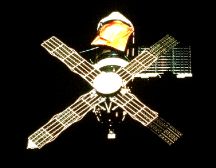Newton's First Law, the Law of Inertia, states that, "Every Object in a state of uniform motion tends to remain in in that state of motion unless an external force is applied to it" If an object is moving then it will remain moving unless some force is applied to it. This can also be true for if it is sitting still, since that would be uniform motion as well.
You may at first think this isnt true since objects slow down and come to rest when there is a force applied. This isn't true, since the reason objects slow down is that there is a force, friction, opposing their movement. An easy way to think about this, is imagining an object in space. It will remain moving indefinitely in the same direction and at the same velocity indefinitely, until some new force acts on it.
In the real world, however, there are forces that aren't clearly noticable. There is friction, air resistance, and other such invisible forces.
In a CGE, the smaller forces, such as air resistance can be ignored, but friction must exist. Friction is a force that always acts in the opposite direction of the motion of a mass. The magnitude of the force of friction relies heavily on a few things, mass, gravity, and the coeficient of friction. Having made a CGE that has gravity defined as a constant, and knowing the mass of the object, it is easy to figure out the force of friction. The coeficient of friction, is simply a variable number between 0 and 1, where 0 means there is no friction at all, and 1 means there is no movement at all. This number can depend on the surface an object is on.
An example of all this could be a model made to walk around in a CGE. The model has a definite mass, and the gravity is constant. Then the programmer can set different levels for the coefficient of friction depending on the surface of the plane they are walking on. Say the model walks on pavement, a coeficient of 0.5 might do well, while if on ice, the coeficient of friction might be 0.1
 Now other than
friction, there are of course the forces needed to actually move an object.
Lets use an example of a race car simulation. The car starts at rest,
with a velocity of 0. Any gas that the driver gives, applies a force that
causes the car to move forwards. Friction would act against the forward
motion, slowing the car. If the driver let off the gas, the friction would
eventually decelerate the car till rest. As long as the driver keeps the
pedal down, however, the car will continue to accelerate. This acceleration
only tops out due to terminal velocity, which is when an object just cannot
accelerate any more due to air resistance.
Now other than
friction, there are of course the forces needed to actually move an object.
Lets use an example of a race car simulation. The car starts at rest,
with a velocity of 0. Any gas that the driver gives, applies a force that
causes the car to move forwards. Friction would act against the forward
motion, slowing the car. If the driver let off the gas, the friction would
eventually decelerate the car till rest. As long as the driver keeps the
pedal down, however, the car will continue to accelerate. This acceleration
only tops out due to terminal velocity, which is when an object just cannot
accelerate any more due to air resistance.
 Going back
to the space sim example, where there is no friction, since there is no
air (air has mass), an object wouldn't need to keep having to apply a
force to keep it moving, since it will continue to move unless some force
acts against it. This is why space crafts can go so long on such little
fuel. Most of the fuel is used up trying to get out of the atmosphere,
since it generates a ton of resistance. Once in free flight, where there
is no friction at all, small thrusts to speed up the craft are all that
are needed. To slow it down, thrusters must apply force in the opposite
direction, decelerating the craft.
Going back
to the space sim example, where there is no friction, since there is no
air (air has mass), an object wouldn't need to keep having to apply a
force to keep it moving, since it will continue to move unless some force
acts against it. This is why space crafts can go so long on such little
fuel. Most of the fuel is used up trying to get out of the atmosphere,
since it generates a ton of resistance. Once in free flight, where there
is no friction at all, small thrusts to speed up the craft are all that
are needed. To slow it down, thrusters must apply force in the opposite
direction, decelerating the craft.
Newton's first law of motion, is a very important law to have in a CGE.